The First All-Union Olympiad of schoolchildren in programming (computer science) 1988
This is the first publication about the first school Olympiads in programming / computer science. The second will be about 1989.
1988 - First All-Union
1989 - First All-Russian
1989 - First International I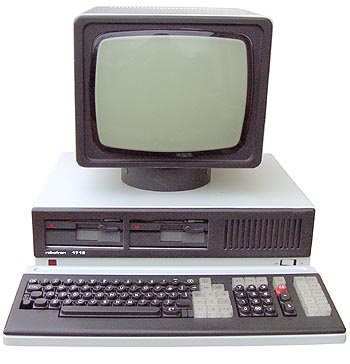
invite all readers to try their hand at solving problems. (And let your friends know the problems to solve)
1988 was the year of Ershov’s loss , Mitnik was treated for computer addiction in a non-strict regime prison, Morris released his worm, the feds just took a breath after Poulsen’s capture , DARPA created a special computer security unit , the German hackers carried out the fifth Chaos Communication Congress, my leg first entered Moscow, in the USSR in Sverdlovsk (Yekaterinburg) the first All-Union Olympiad in computer science was held.
About the level of technology of that time, the post “Soviet personal computers”
on April 13-20, 80 schoolchildren from all union republics mastered the Robotron-1715 computers for 2 days ( on the right in the photo), and then they solved six problems.
The Olympiad consisted of two rounds - Theoretical (4 tasks) and Machine (2 tasks).
April 15th. It was carried out in writing, without access to a computer . 3.5 hours to complete tasks. Languages - Pascal, Rapira, C, Algol, Fortran, the algorithmic language of the computer science course, etc.
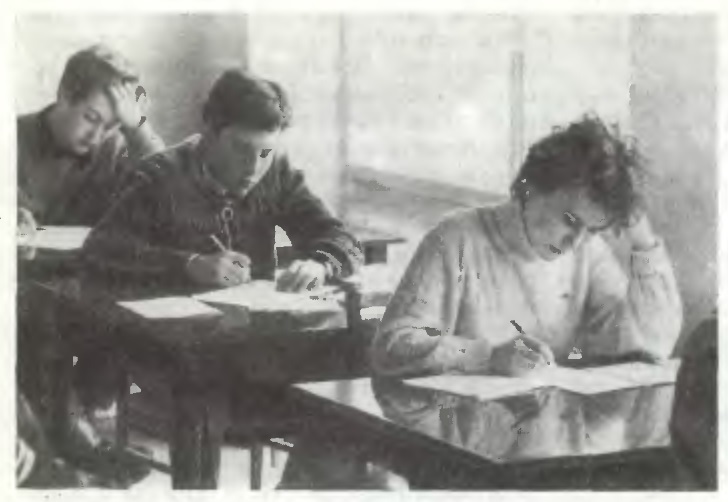
The task of compiling the algorithm is considered solved if the presented algorithm is correct (satisfies all the requirements of the condition). The jury has the right to consider the problem unsolved if the algorithm is so confused that the jury could not establish its correctness or incorrectness. Additional points can be awarded for the simplicity and originality of the algorithm, the justification of its correctness, the presence of comments to facilitate its reading, as well as for the effectiveness of the algorithm (short operating time, low memory usage). At the end of some tasks, the effectiveness of the well-known jury of algorithms is indicated; these instructions are not mandatory requirements. Evaluation can be lowered for serious syntax errors in the algorithm record, making it difficult to understand.
Task 1:
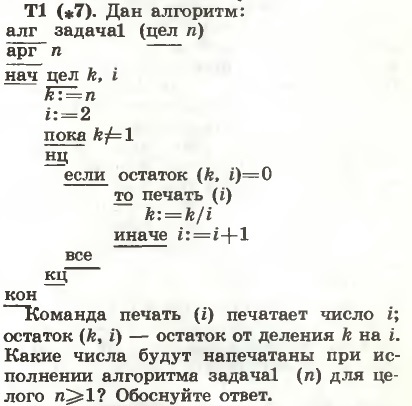
Task 2:

Task 3:
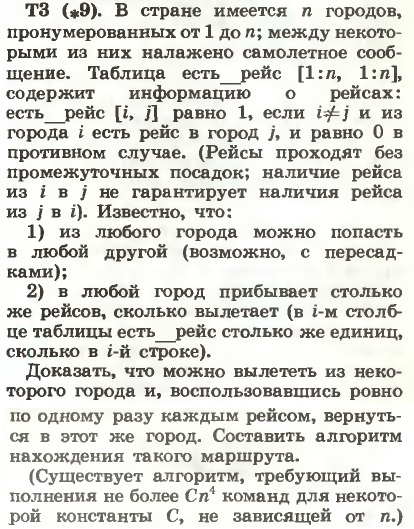
Task 4:

Acceptable programming languages were BASIC or Pascal.
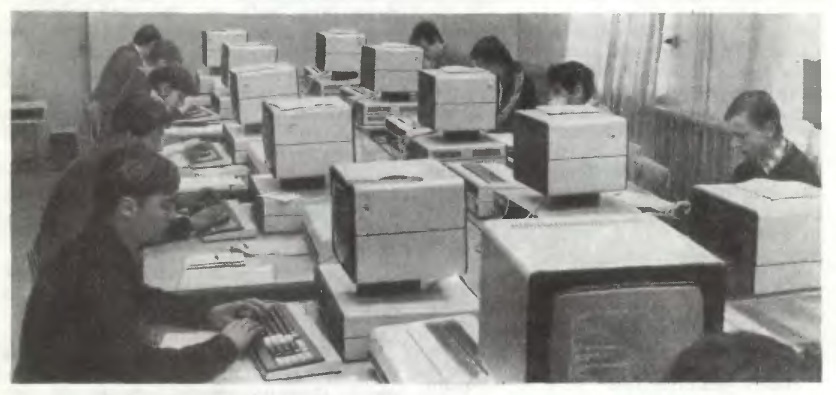
In the tasks of the machine tour, the achieved result was evaluated, using a computer was only a means. Additional points were evaluated for the description of the solution method, its justification, comments on the program, etc.
Task 1:

Task 2: The
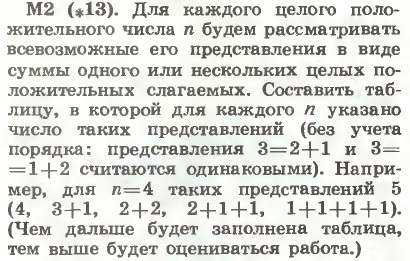
analysis of the tasks was carried out on April 18 in the morning, and in the evening there was an appeal.
The next day, atorrent exchange of computer programs among the participants of the computer festival took place.
Following the results of the Olympiad, the first champion was Alexander Vashchillo (lives in America, works at MS), a student of secondary school No. 239 in Leningrad. The second place was taken by Vadim Zavalishin (it seems to work with sound , his book was mentioned in the article on Habré ), a student of secondary school No. 542 at Moscow Engineering Physics Institute, and the third place was Vyacheslav Kalashnikov from Moscow secondary school No. 57. (I wonder if there is any of them on Habré) Decisions once lay here Article in the Quantum magazine



1988 - First All-Union
1989 - First All-Russian
1989 - First International I

invite all readers to try their hand at solving problems. (And let your friends know the problems to solve)
Context
1988 was the year of Ershov’s loss , Mitnik was treated for computer addiction in a non-strict regime prison, Morris released his worm, the feds just took a breath after Poulsen’s capture , DARPA created a special computer security unit , the German hackers carried out the fifth Chaos Communication Congress, my leg first entered Moscow, in the USSR in Sverdlovsk (Yekaterinburg) the first All-Union Olympiad in computer science was held.
About the level of technology of that time, the post “Soviet personal computers”
on April 13-20, 80 schoolchildren from all union republics mastered the Robotron-1715 computers for 2 days ( on the right in the photo), and then they solved six problems.
The Olympiad consisted of two rounds - Theoretical (4 tasks) and Machine (2 tasks).
History and background of the Olympiad in computer science
The Olympiad movement in computer science, unlike subjects such as mathematics, physics, and chemistry, has a relatively recent history. Despite the fact that the first computer appeared in 1949, the understanding that with the development of computer technology the era of new information technologies was beginning only arose in the late 70s.
In the spring of 1985, a party-government resolution was adopted “On measures to ensure computer literacy of students in secondary schools and the widespread introduction of electronic computing technology in the educational process,” and already in the fall of 1985, teaching of the course “Fundamentals of Computer Science and Computing” began in all schools of the country technicians. "
Prominent academicians A.P. Ershov, E.P. Velikhov, B.N. Naumov and others immediately joined in solving the complex tasks of teaching school informatics. Thanks to this, in a fairly short period of time, teams were formed in the country that could, based on our entire educational, scientific, industrial, and cultural computer infrastructure, solve the tasks posed in education in a short time.
The birth of informatics olympiads was the next important step in creating the infrastructure for teaching informatics at school, since for the intensive movement of the country in the direction of informatization, computer universal education was clearly not enough. We need more highly qualified specialists who are able to develop tomorrow’s information technology.
Now it’s hard to say who first came up with the idea of holding All-Union Olympiads in computer science for schoolchildren, but it is obvious that such an interesting and rapidly developing subject could not remain without an Olympiad for a long time. In the fall of 1987, the first organizational meeting was held at the USSR Ministry of Education, which was attended by Academicians A.P. Ershov, N.N. Krasovsky, Dr. Sci. A.L. Semenov, Ph.D. Associate Professor V.M. Kiryukhin, as well as a representative of the Ministry and a member of the Central Organizing Committee of the All-Union Olympiad for schoolchildren T.A. Sarycheva. At the meeting, it was decided to hold the country's first computer science Olympiad in the spring of 1988 in Sverdlovsk, now Yekaterinburg.
Sverdlovsk was not accidentally chosen as the city of the first Olympiad: at that time, Robotron-1715 personal computers were already delivered to many schools in the city and the Sverdlovsk Region, a modern program and textbooks for teaching school computer science were developed at that time.
At the first organizational meeting, the Regulation on the Informatics Olympiad was also agreed and the chairmen of the program committee and the jury were appointed. Academician A.P. Ershov became the chairman of the program committee, and academician N.N. Krasovsky became the chairman of the jury.
The first Olympiad in Informatics, which was held in Sverdlovsk from April 13 to 20, 1988, was called not yet All-Russian, but All-Union, with 80 schoolchildren from all Union republics taking part in it.
At that time, there was no experience in organizing such competitions either in the country or in the world. In order to determine the methodology and content of informatics olympiads, the best specialists at that time in the field of school informatics and the olympiad movement, one representative from each union republic and each territory of the Russian Federation, were invited as jury members. As a result of long disputes and discussions, those rules were gradually formed that were the basis for the rules for conducting modern olympiads.
The quantitative composition of the participants in the first Olympiads was determined taking into account the available capabilities in providing computers and in proportion to the number of schoolchildren in the Union republics and territories of the Russian Federation.
Starting from the III All-Union Olympiad, held in 1990 in Kharkov, it was decided to conduct both rounds of the Olympiad using computers. Prior to this, the first round was theoretical, without the use of computers, the second round was practical.
The Olympiad, held in 1992 in Mogilev, was called the Interstate, it was attended by schoolchildren from almost all states, formed after the collapse of the USSR.
At the same time as the All-Union Olympiads from 1989 to 1991, the All-Russian Olympiads were also held, which were the republican stage of the All-Union Olympiad. Since 1992, they began to be held in the same format as the All-Union Olympiads in Informatics.
In 1992, a new Regulation was adopted on the All-Russian Olympiads for schoolchildren, according to which the third stage was conducted by the educational authorities of the Russian Federation, and the final stage by the Ministry of Education of the Russian Federation. The winners of the third stage of the Olympiad of all subjects of the Russian Federation were invited immediately to participate in the final stage of the Olympiad.
In 1992-1996, the capital of the Olympiad movement in computer science was Troitsk, Moscow Region, which was due to the presence of a specialized Troitsk informatics center “Baytik” and, as a result, good computer equipment. In 1997-1999, the final stage of the Olympiads was held in St. Petersburg. In subsequent years, the successful development of the country's economy and the increased attention of federal and regional education authorities to the issues of education informatization significantly expanded the geography of the final stage of the All-Russian Olympiads in Informatics: from 2000 to 2005, the Olympiad was held in the cities of Troitsk, Yekaterinburg, Perm, St. Petersburg , Tver region and Novosibirsk.
During the international and All-Russian Olympiads in Informatics and Programming for schoolchildren and students, a huge organizational experience has been accumulated, the interaction of various links in the training system of gifted young specialists in the field of informatics and information technologies, which have made a significant contribution to the development of the country's informatization, has been established. High-class specialists and teachers work with the guys, focused not only on the immediate result, that is, on the prizes for their wards, but also on the long-term prospect - on educating the future shift of specialists in the field of information technology and programming.
The permanent chairman of the Central Methodological Commission on Informatics is V.M. Kiryukhin. The oldest members of this commission are the country's famous scientists and teachers in the field of school and olympiad informatics - professors S.M.Okulov, V.V.Prokhorov, I.V. Romanovskiy, associate professors A.V. Alekseev, S.G. Volchenkov, E.V. Andreeva, V.D. Lelyukh.
old.info.rosolymp.ru/default.asp?trID=96
In the spring of 1985, a party-government resolution was adopted “On measures to ensure computer literacy of students in secondary schools and the widespread introduction of electronic computing technology in the educational process,” and already in the fall of 1985, teaching of the course “Fundamentals of Computer Science and Computing” began in all schools of the country technicians. "
Prominent academicians A.P. Ershov, E.P. Velikhov, B.N. Naumov and others immediately joined in solving the complex tasks of teaching school informatics. Thanks to this, in a fairly short period of time, teams were formed in the country that could, based on our entire educational, scientific, industrial, and cultural computer infrastructure, solve the tasks posed in education in a short time.
The birth of informatics olympiads was the next important step in creating the infrastructure for teaching informatics at school, since for the intensive movement of the country in the direction of informatization, computer universal education was clearly not enough. We need more highly qualified specialists who are able to develop tomorrow’s information technology.
Now it’s hard to say who first came up with the idea of holding All-Union Olympiads in computer science for schoolchildren, but it is obvious that such an interesting and rapidly developing subject could not remain without an Olympiad for a long time. In the fall of 1987, the first organizational meeting was held at the USSR Ministry of Education, which was attended by Academicians A.P. Ershov, N.N. Krasovsky, Dr. Sci. A.L. Semenov, Ph.D. Associate Professor V.M. Kiryukhin, as well as a representative of the Ministry and a member of the Central Organizing Committee of the All-Union Olympiad for schoolchildren T.A. Sarycheva. At the meeting, it was decided to hold the country's first computer science Olympiad in the spring of 1988 in Sverdlovsk, now Yekaterinburg.
Sverdlovsk was not accidentally chosen as the city of the first Olympiad: at that time, Robotron-1715 personal computers were already delivered to many schools in the city and the Sverdlovsk Region, a modern program and textbooks for teaching school computer science were developed at that time.
At the first organizational meeting, the Regulation on the Informatics Olympiad was also agreed and the chairmen of the program committee and the jury were appointed. Academician A.P. Ershov became the chairman of the program committee, and academician N.N. Krasovsky became the chairman of the jury.
The first Olympiad in Informatics, which was held in Sverdlovsk from April 13 to 20, 1988, was called not yet All-Russian, but All-Union, with 80 schoolchildren from all Union republics taking part in it.
At that time, there was no experience in organizing such competitions either in the country or in the world. In order to determine the methodology and content of informatics olympiads, the best specialists at that time in the field of school informatics and the olympiad movement, one representative from each union republic and each territory of the Russian Federation, were invited as jury members. As a result of long disputes and discussions, those rules were gradually formed that were the basis for the rules for conducting modern olympiads.
The quantitative composition of the participants in the first Olympiads was determined taking into account the available capabilities in providing computers and in proportion to the number of schoolchildren in the Union republics and territories of the Russian Federation.
Starting from the III All-Union Olympiad, held in 1990 in Kharkov, it was decided to conduct both rounds of the Olympiad using computers. Prior to this, the first round was theoretical, without the use of computers, the second round was practical.
The Olympiad, held in 1992 in Mogilev, was called the Interstate, it was attended by schoolchildren from almost all states, formed after the collapse of the USSR.
At the same time as the All-Union Olympiads from 1989 to 1991, the All-Russian Olympiads were also held, which were the republican stage of the All-Union Olympiad. Since 1992, they began to be held in the same format as the All-Union Olympiads in Informatics.
In 1992, a new Regulation was adopted on the All-Russian Olympiads for schoolchildren, according to which the third stage was conducted by the educational authorities of the Russian Federation, and the final stage by the Ministry of Education of the Russian Federation. The winners of the third stage of the Olympiad of all subjects of the Russian Federation were invited immediately to participate in the final stage of the Olympiad.
In 1992-1996, the capital of the Olympiad movement in computer science was Troitsk, Moscow Region, which was due to the presence of a specialized Troitsk informatics center “Baytik” and, as a result, good computer equipment. In 1997-1999, the final stage of the Olympiads was held in St. Petersburg. In subsequent years, the successful development of the country's economy and the increased attention of federal and regional education authorities to the issues of education informatization significantly expanded the geography of the final stage of the All-Russian Olympiads in Informatics: from 2000 to 2005, the Olympiad was held in the cities of Troitsk, Yekaterinburg, Perm, St. Petersburg , Tver region and Novosibirsk.
During the international and All-Russian Olympiads in Informatics and Programming for schoolchildren and students, a huge organizational experience has been accumulated, the interaction of various links in the training system of gifted young specialists in the field of informatics and information technologies, which have made a significant contribution to the development of the country's informatization, has been established. High-class specialists and teachers work with the guys, focused not only on the immediate result, that is, on the prizes for their wards, but also on the long-term prospect - on educating the future shift of specialists in the field of information technology and programming.
The permanent chairman of the Central Methodological Commission on Informatics is V.M. Kiryukhin. The oldest members of this commission are the country's famous scientists and teachers in the field of school and olympiad informatics - professors S.M.Okulov, V.V.Prokhorov, I.V. Romanovskiy, associate professors A.V. Alekseev, S.G. Volchenkov, E.V. Andreeva, V.D. Lelyukh.
old.info.rosolymp.ru/default.asp?trID=96
Theoretical tour
April 15th. It was carried out in writing, without access to a computer . 3.5 hours to complete tasks. Languages - Pascal, Rapira, C, Algol, Fortran, the algorithmic language of the computer science course, etc.

The task of compiling the algorithm is considered solved if the presented algorithm is correct (satisfies all the requirements of the condition). The jury has the right to consider the problem unsolved if the algorithm is so confused that the jury could not establish its correctness or incorrectness. Additional points can be awarded for the simplicity and originality of the algorithm, the justification of its correctness, the presence of comments to facilitate its reading, as well as for the effectiveness of the algorithm (short operating time, low memory usage). At the end of some tasks, the effectiveness of the well-known jury of algorithms is indicated; these instructions are not mandatory requirements. Evaluation can be lowered for serious syntax errors in the algorithm record, making it difficult to understand.
Task 1:

Task 2:

Task 3:

Task 4:

Machine tour
Acceptable programming languages were BASIC or Pascal.

In the tasks of the machine tour, the achieved result was evaluated, using a computer was only a means. Additional points were evaluated for the description of the solution method, its justification, comments on the program, etc.
Task 1:

Task 2: The

analysis of the tasks was carried out on April 18 in the morning, and in the evening there was an appeal.
The next day, a
Prizewinners
Following the results of the Olympiad, the first champion was Alexander Vashchillo (lives in America, works at MS), a student of secondary school No. 239 in Leningrad. The second place was taken by Vadim Zavalishin (it seems to work with sound , his book was mentioned in the article on Habré ), a student of secondary school No. 542 at Moscow Engineering Physics Institute, and the third place was Vyacheslav Kalashnikov from Moscow secondary school No. 57. (I wonder if there is any of them on Habré) Decisions once lay here Article in the Quantum magazine



Only registered users can participate in the survey. Please come in.
I solved ... tasks
- 28.9% 6 70
- 8.6% 5 21
- 11.5% 4 28
- 4.1% 3 10
- 4.1% 2 10
- 6.6% 1 16
- 35.9% tried very hard, but "0" 87
